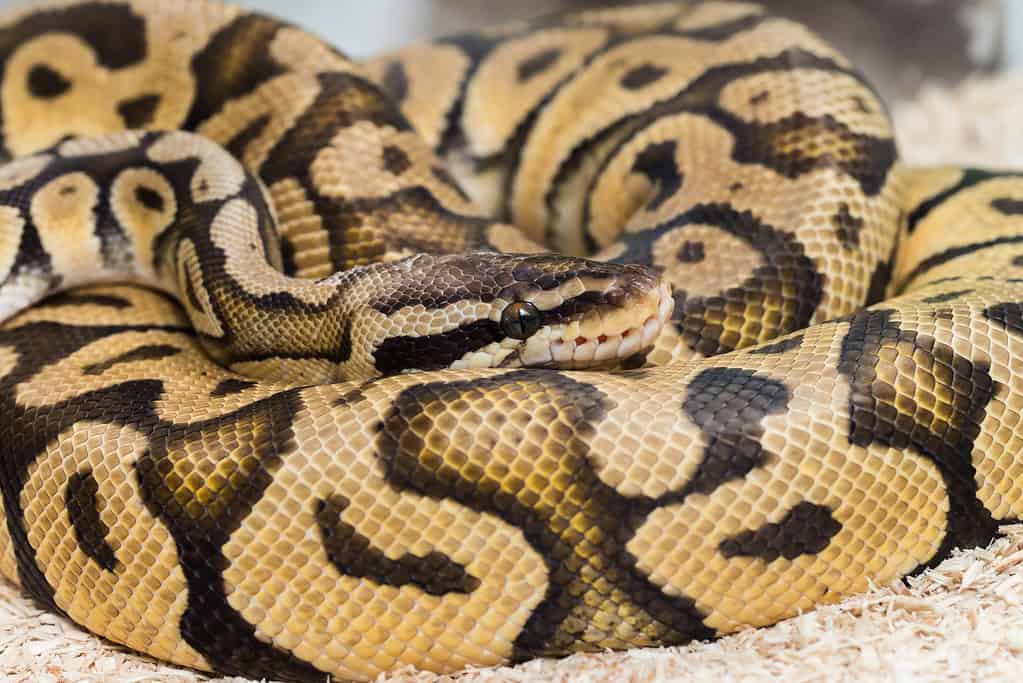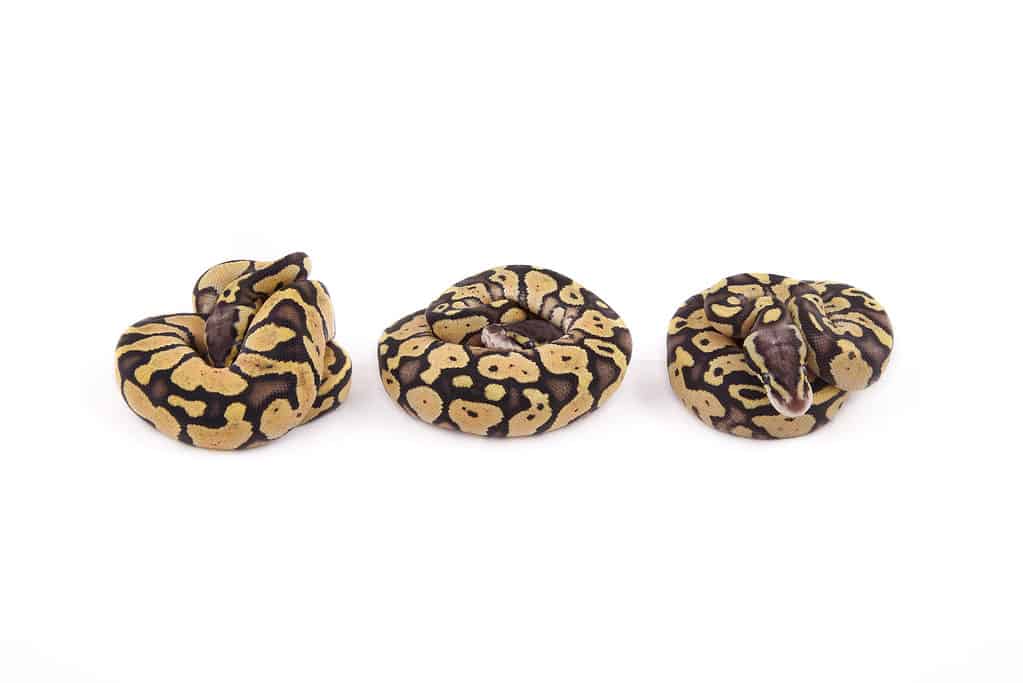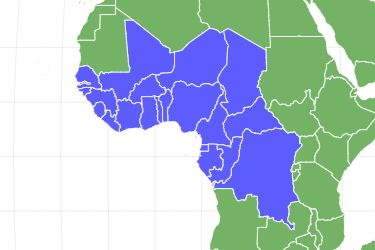Firefly Ball Python
Python regius
Advertisement
Firefly Ball Python Scientific Classification
- Kingdom
- Animalia
- Phylum
- Chordata
- Class
- Reptilia
- Order
- Squamata
- Family
- Pythonidae
- Genus
- Python
- Scientific Name
- Python regius
Read our Complete Guide to Classification of Animals.
Firefly Ball Python Conservation Status
Firefly Ball Python Facts
- Prey
- Rodents, birds, amphibians, fish
- Main Prey
- Small rodents
- Group Behavior
- Solitary
- Most Distinctive Feature
- Bold yellow and black coloration
- Temperament
- Docile, curious, hardy
- Habitat
- Grasslands, savannas, forests
- Diet
- Carnivore
- Lifestyle
- Nocturnal
- Favorite Food
- Rats and mice
- Location
- Central/western Africa
View all of the Firefly Ball Python images!
Firefly Ball Python Summary
“Mainly electric yellow and almost jet black in color, the firefly ball python morph is stunningly bright and bold with extremely clean, defined markings.”
Even out of thousands of colorful and unique ball python morphs on the market, the firefly morph manages to be one of the boldest and brightest of all. Originally developed in 2006 by breeder Brandon Boeke, this designer morph is a brilliant combination of the popular pastel and fire traits.
With its bright yellow body accented by dark brown or black banded markings, the firefly ball python retains the pastel morph’s bright coloration and the fire morph’s rich yellows and dark, striking markings. It also has much cleaner patterning with less blushing and faded patches than its pastel and fire parents. What’s more, its bold yellow and golden tones only become more vibrant with age.
In more recent years, reptile breeders have used this morph to develop newer designer morphs, such as the super firefly, firefly clown, and Enchi firefly varieties. This is mainly because the firefly trait tends to brighten and enhance its offspring’s coloration and patterning.
3 Amazing Firefly Ball Python Facts!
- The firefly morph has very little blushing or faded patches on its skin compared to many other designer morphs, resulting in a very “clean” and bold pattern with heavily contrasting yellow and black tones.
- Although the base morphs that make up the firefly morph can technically occur naturally in the wild, the firefly morph itself is a designer morph that requires selective breeding in captivity.
- Baby firefly ball pythons tend to have more muted colors and faded patterning that slowly become more vibrant and defined with age. By around one to two years of age, most firefly ball pythons will have achieved their full color potential.
Where to Find Firefly Ball Pythons
The ball python, or alternatively the royal python, is native to central and western Africa’s savannas, grasslands, and forests. It mainly resides along the continent’s Sub-Saharan region, with large populations in countries like Ghana, Senegal, and Cameroon.
Firefly ball pythons, as briefly touched on above, cannot naturally exist in the wild. This designer morph has two specific traits, the pastel and fire, that require selective breeding. Some base morphs can technically be born in the wild, but this is very rare, with almost no actual documented cases.
In captivity, though, firefly ball pythons are quite common among reptile breeders and hobbyists. The morph has remained popular since its development in 2006, with many breeders worldwide producing their own lines of firefly snakes and selling them online as well as at events like reptile expos.
On average, firefly ball pythons cost around $100 to $300 each. This will vary based on the snake’s coloration and overall genetic expression, the morph’s current supply and demand, and where you purchase the snake.
Firefly Ball Python Scientific Name
Python regius is the ball python’s scientific name. It is a member of the Python family, with its full taxonomic name translating roughly to “royal python.”
This regal moniker is a nod to the common belief that royalty in ancient Egypt wore actual snakes around their wrists and necks as live jewelry to flaunt their status. These snakes were likely baby ball pythons, since they were non-venomous and non-aggressive!
All ball python morphs have the same scientific name since they are all part of the same species.
Firefly Ball Python Population & Conservation Status
Since 2012, the IUCN Red List has designated the ball python as near threatened. Even though it isn’t anywhere near becoming extinct in the wild for the time being, this status could potentially change in the future for a few key reasons.
The species has been experiencing a slight decline in its overall population within much of its native habitat in Africa. The main culprit is habitat loss caused primarily by the agricultural industry’s rapid expansion throughout many Sub-Saharan African countries. Humans also commonly remove ball pythons from their native habitats while hunting them for food or trapping them to sell in the exotic pet trade.
There is currently no further data on the ball python’s exact numbers in the wild or in captivity.
How to Identify Firefly Ball Python: Appearance and Description
As a combination of the bright and bold fire and pastel traits, it’s no surprise the firefly morph’s name suits it so perfectly. Its neon, almost electric yellow body contrasts with its dark brown to nearly black markings. This gives its color palette a distinctly firefly or lightning bug-like boldness as if its entire body were constantly glowing, making it somewhat similar to the also-popular bumblebee designer morph.
Aside from a single pale spot on top of the snake’s head, it has almost no blushing or fading whatsoever. This morph’s markings are so bold and clearly defined that reptile breeders now commonly combine it with other traits to “clean up” or “enhance” their patterning and brighten their overall coloration.
Look closely for the following traits to properly identify a firefly ball python:
- Mostly yellow body that can range from a warm, sunny gold to a bright, neon lemony tone
- Very dark, almost black banded markings
- Extremely bold, well-defined patterning and very little to no blushing
- High contrast between its yellow and black patterning
Firefly Ball Python Evolution and History
Even though ball pythons have been prominent in the exotic pet trade since the mid-1990s, the firefly morph in particular has only existed since around 2006. Reptile breeder Brandon Boeke primarily developed it. As a designer morph, it contains two co-dominant traits, or base morphs: the fire and pastel traits. Designer morphs cannot be born in the wild naturally, as very specific, selective breeding conditions are necessary to combine particular genetic traits with one another.
Although the firefly morph is a bit more recent in the overall timeline of designer ball python morphs, the fire and pastel traits it contains were among the first base morphs to become popular within the exotic pet trade.
The pastel morph was first proven and developed in 1997 by the breeders at New England Reptile Distributors. It is a fairly subtle, basic morph compared to most modern designer varieties. Still, it remains very useful for combining with other traits to brighten the resulting offspring’s overall coloration, particularly its yellow markings.
Meanwhile, the fire morph is a color-enhancing morph that developed around six years later in 2003. Its overall coloration and patterning are similarly lighter and brighter than that of a normal, wild-type ball python. It also has warmer, more golden tones overall.
As we touched on earlier, these two traits finally came together in 2006 to create the firefly morph we know and love today.

The firefly morph’s neon, almost electric yellow body contrasts with its dark brown to nearly black markings.
©Natnaphit/Shutterstock.com

Ball pythons will curl into a submissive position when threatened.
©Sanne Romijn Fotografie/Shutterstock.com
Firefly Ball Python: How Dangerous Are They?
The ball python has become one of the most popular and well-loved pet reptiles in the world mainly thanks to its uniquely tame, friendly, and gentle temperament. Though it can be somewhat timid and prefers a solitary lifestyle with no tankmates, it is remarkably cooperative and docile around humans. Its calm personality along with its small size and non-venomous status make it arguably one of the least dangerous snakes on the planet.
Rather than biting or rearing up into a defensive, cobra-like stance, ball pythons curl their bodies tightly into a tiny ball when they are frightened or threatened. Their bodies are small and their thin, fragile teeth aren’t particularly effective at biting into larger animals, so they prefer to flee or assume their trademark “ball” posture.
Only in rare circumstances will a ball python resort to biting a human. In nearly all cases, ball python bites are minor and need very little medical attention. If one of these snakes bites you, simply gently place the snake back into its enclosure, ensuring it is not injured. Carefully wash the bite wound with soap and warm water. If necessary, bandage the wound to protect it from becoming infected and encourage the healing process.
Ball python morphs generally all share the same overall temperament as they have been selectively bred for their appearance rather than personality traits.
Firefly Ball Python Behavior and Humans
Ball pythons have become so popular as pets that reptile breeders have managed to produce thousands of unique color and pattern morphs! The ball python, along with the equally popular corn snake, is currently one of the most abundant and widespread pet snakes in the world.
Their massive popularity and long relationship with humans is due to a few main factors: the snake’s small size, its rather cute facial features, its hardiness and success in captivity, and, of course, its timid yet intelligent and gentle personality. As a fairly intelligent and active snake, it can also be entertaining to observe. Maxing out at around 5 feet long, ball pythons are manageable to raise even for beginners. They fare quite well in captivity.
Since ball pythons are mainly selectively bred for their appearance, most morphs have the same overall temperament. This means prospective ball python owners have practically endless color and pattern options to choose from. The firefly morph remains one of the most popular designer morphs on the market, even more than 15 years after its initial introduction to the pet trade.
Related Animals
View all 91 animals that start with FFirefly Ball Python FAQs (Frequently Asked Questions)
Are Firefly ball pythons venomous?
Ball pythons are non-venomous snakes. They do not have fangs and cannot inject or produce venom. This goes for all ball python morphs, as they are all part of the same species.
How do Firefly ball pythons hunt?
Ball pythons are ambush hunters that mostly hunt rodents like rats and mice as well as small birds.
To find food, they will sit and wait very quietly, usually while camouflaged amongst dense foliage, for a prey animal to wander within their striking range. At the ideal moment, the snake will strike, gripping the prey animal with its many sharp, small teeth. Next, the ball python will quickly wrap the rest of its body around the animal as tightly as possible, usually suffocating it within minutes. Finally, it will swallow the animal whole and digest it over the following days.
Where do Firefly ball pythons live?
Ball pythons are native to western and central parts of Africa, mainly within the Sub-Saharan region. They are incredibly hardy animals that can live comfortably in various habitats like grasslands, savannas, and even forests.
Notably, designer morphs like the Firefly variety do not exist in the wild. They must be bred in captivity. They are made up of multiple specific genetic traits that can only be reliably combined via selective breeding.
Are Firefly ball pythons rare?
Firefly ball pythons are fairly common within the reptile trade today, as the morph has existed since 2006. Various reptile breeders have also created their own lines of Firefly ball pythons. There are many potential sources to purchase them from both online and in-person. Because they are a designer morph, however, they are virtually non-existent in the wild.
How much do Firefly ball pythons cost?
The average Firefly ball python costs around $100 to $300. Many factors can affect this price range, including the breeder selling the snake, the snake’s exact genetic expression and overall appearance, and the current supply and demand for the morph.
Are Firefly ball pythons aggressive?
Ball pythons are adept hunters, but they are not aggressive toward humans. In fact, they are one of the least aggressive snakes in the world. Their small size renders them unable to hunt prey much larger than a common rat.
What do Firefly ball pythons eat?
Ball pythons are carnivores that feed mainly on small rodents and birds. They will also occasionally hunt amphibians and small fish. In captivity, most pet owners feed their ball pythons captive-bred rats and mice that are frozen and meant to be thawed just prior to feeding.
Thank you for reading! Have some feedback for us? Contact the AZ Animals editorial team.
Sources
- Animal Diversity (1970) animaldiversity.org/accounts/Python_regius/
- IUCN Redlist (1970) iucnredlist.org/species/177562/15340592
- NW Reptiles (1970) nwreptiles.com/firefly/
- San Diego Zoo (1970) animals.sandiegozoo.org/animals/python
- World of ball pythons (1970) worldofballpythons.com/morphs/firefly/

















